Gardeners talk a lot about amending
soils for plants in their beds and borders and this is
generally a good thing, however, trees are a separate
matter. The root zone of most trees spreads out at least as
far as the height of the tree. That is, for a 100 foot tall
tree, the root system could spread out up to 100 feet in all
directions under optimum conditions. A few species will send
roots out even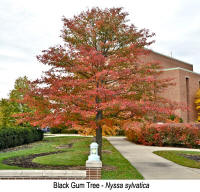 further while some, like spruce trees, will
not spread roots nearly so far on average.
further while some, like spruce trees, will
not spread roots nearly so far on average.
Another thing to consider is that the vast majority of the
roots of trees and shrubs go out horizontally. By far the
bulk of roots of these plants are found in the top 18 to 24
inches of soil. Why? Because that is where the water and
nutrients are located. There are certainly some roots that
go deep into the ground to help anchor the tree and there
are some species that send down a true taproot. However, the
roots that the tree depends on for survival are near the
soil surface.
On a practical basis, it would be impossible to amend enough
soil to account for a tree's mature root zone. Therefore,
they must survive in the native soils alone without any
amendments like peat moss or compost. If your soils are
heavy clay or extremely light
sand, you have a problem or,
at least, a challenge. No doubt about it. In these cases, we
just have to use some techniques that allow us to do the
best we can and then leave it up to the plant to
survive...or not.
A. Planting Trees in Standard Soil Conditions - Many garden soils are a somewhat
uniform mixture of
sand,
silt and
clay and fall into what is
commonly called a "loam" soil type. Such soils have good
drainage and there is no evidence of ponding or puddling
after a summer storm. Water drains off quickly leaving the
soil moist but not waterlogged. Also, these soils are not
excessively sandy which would cause water to disappear too
rapidly and would be considered droughty. These favorable
characteristics would result in what we might call a
"standard" or "typical" soil for many home landscapes.
In these kinds of general conditions, the rule about
planting at the same depth as the plant was growing at its
previous site applies most of all. If the root ball of the
tree is 12 inches high, dig a hole that is12 inches deep and
as wide as you can reasonably go. Then take the shovel and
loosen the soil to about that depth out to the sides of the
root ball. This will add air to the soil and encourage tree
roots to grow laterally over the coming years.
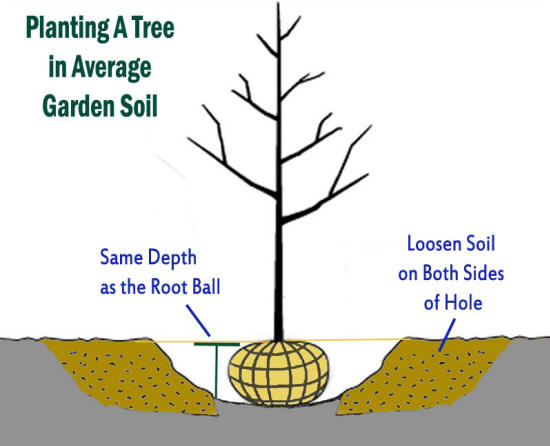
B. Planting Trees in Heavy Clay Soils - The exception to the general planting
depth rule is to plant trees "high" in poorly drained
clay
soils. Here, we are trying to make the best of a bad
situation. If you are one of those super rich gardeners, you
could consider changing huge amounts of soil throughout the
entire potential root zone of the tree. For most of us
common folks, however, we will just have to make the best of
the soil we have on our site.
In clay soils, if we dig a standard type of hole, it may
form what is called the "bathtub effect". In this case,
especially if the clay is wet when being dug, the sides of
the hole will be slick like the ceramic coating on a
bathtub. It will dry very hard and rainwater will sit in the
hole for days and days before very slowly draining away. In
this situation, at the very least, the roots will not expand
and at the worst, they will rot away.
In heavy clay soils, we will dig a saucer shaped hole that
is shallow and as wide as we can make it. If the root ball
is 12 inches tall, we might dig the hole 8 or 9 inches deep.
Then, when the soil that was taken from the hole is
replaced, it will form a bit of a slope away from the trunk
of the tree. This will allow for a certain amount of surface
drainage. By making the hole as wide as you can, the roots
will be encouraged to expand out horizontally into the newly
disturbed soil.
Since the root ball is standing above the regular soil level
a bit, this is one case where staking may be needed to keep
the tree from falling over in the breeze. We cover staking
later in this eBook.
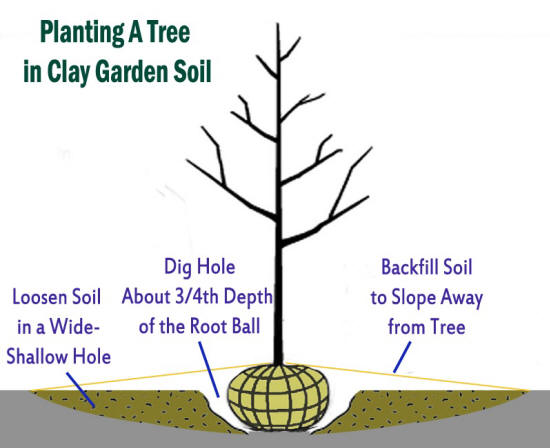
C. Planting Bare Root Trees - Trees or other woody plant material
that come to you bare root should be planted as soon as
possible after delivery. The day before you plant, you
should put the roots of the tree in a pail of water so that
it can replenish its supply.
Follow the relevant depth rules discussed in A & B above
depending on the type of soil. In the bottom of the hole,
build a mound in a cone shape and spread the roots out on
top of it. You can add or subtract some soil from the cone
until the trunk is at the proper height above the soil line.
Loosen the soil on both sides of the hole to the correct
depth. Then, fill the hole with soil that came out of during
excavation. Water the area near the trunk thoroughly to
remove any large air pockets that might be trapped in the
soil.
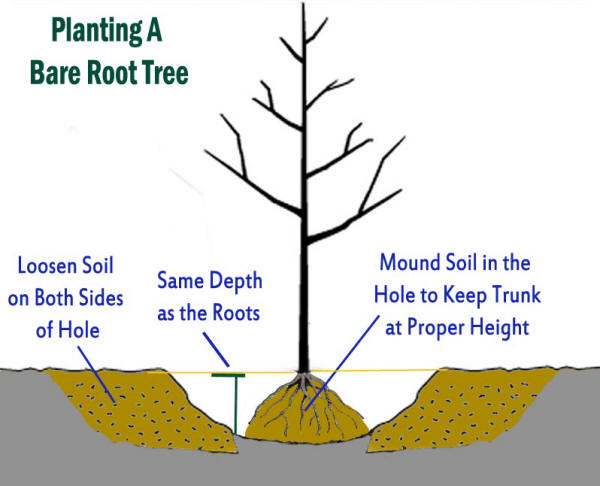
D. Planting Balled and Burlaped Trees - Follow the relevant depth rules
discussed in A & B above depending on the type of soil. The
key factor with planting B&B nursery stock is that it is
very important to cut and/or remove all ropes, wires and
strings used to hold the ball together once the plant is in
the hole. If any are wrapped around the base of the trunk,
it is imperative that these be cut or as the tree grows in
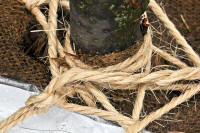 girth, it may be girdled and die within a few years after
planting. Sometimes the strings will be called
"biodegradable" and this may be true. However, it is not
worth taking the long-term risk. Cut them all!
girth, it may be girdled and die within a few years after
planting. Sometimes the strings will be called
"biodegradable" and this may be true. However, it is not
worth taking the long-term risk. Cut them all!
Loosen the soil on both sides of the hole to the correct
depth. Then, fill the hole with soil that came out of it
during excavation. Make sure that the burlap is buried
beneath the soil surface or this will act as a wick and take
moisture away from the roots. Irrigate the area near the
trunk thoroughly to remove any large air pockets that might
be trapped in the soil.
E. Planting Container Grown Trees - Follow the relevant depth rules
discussed in A & B above depending on the type of soil.
Since the plants have been growing in the container for a
year or more, they should have built a solid root mass.
Often, the roots have completely filled the container and
some of them may be circling around the inside of the pot.
If you just plop this root mass into the soil, those roots
will continue to grow in a circle and may eventually wrap
around the trunk. That can girdle the trunk and result in
the death of the tree. Unfortunately, this may not happen
for as much as a decade or more after the date of
transplant.
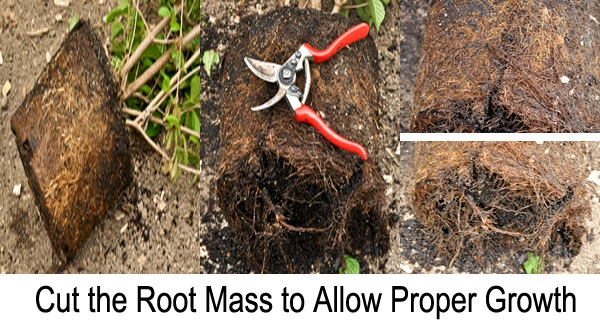
So, it is important to take a sharp tool of some sort and
cut those circling roots. It is also vital that you cut
through the matted roots on all four sides and cut in a
cross shape across the bottom of the root mass.
Loosen the soil on both sides of the hole to the correct
depth. Then, fill the hole with soil that came out of during
excavation. Water the area near the trunk thoroughly to
remove any large air pockets that might be trapped in the
soil.
While concentrating on the proper depth of planting is very
important, don't forget to take a look at the above ground
portion of the tree too. Be sure that the branches of the
canopy are properly aligned for maximum viewing and proper
growth. Also, be sure the trunk is perpendicular with the
ground before you refill the hole.



